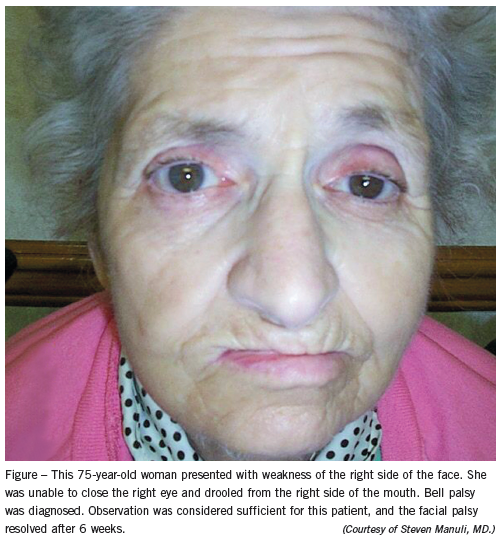Bell Palsy: Updated Guideline for Treatment
Primary Care Update
Brief Summaries for Clinical Practice
Most patients with Bell palsy regain normal facial function within 3 weeks—even those who do not receive treatment.1 The severity of the palsy at 2 weeks after symptoms occur indicates the likelihood of long-term sequelae. An improvement in symptoms 1 to 2 weeks after their onset is a good predictor of a full recovery.1 However, about 15% of patients do not recover completely and are left with residual facial weakness.2
Many treatments—including corticosteroids, antivirals, and surgical decompression—have been used in patients with Bell palsy. Studies that have evaluated the effectiveness of these treatments must be interpreted with caution because the majority of patients recover without therapy (Figure).
In 2001, the Quality Standards Subcommittee of the American Academy of Neurology (AAN) conducted a systematic review and analysis of the literature to assess the effectiveness of treatments in improving facial function outcomes in patients with Bell palsy.3 Recently, the AAN updated its 2001 guideline; highlights are presented here.4

RECOMMENDED TREATMENT
Oral corticosteroids are the mainstay of treatment because they can improve the likelihood of full recovery of facial function in patients with new-onset Bell palsy. Thus, the authors of the AAN updated guideline recommend that early corticosteroid therapy be offered to patients who do not have contraindications, such as brittle diabetes mellitus, morbid obesity, osteopenia, and a previous history of corticosteroid intolerance.4
Antiviral therapy alone has not been shown in well-designed studies to increase the likelihood of full facial recovery. Antiviral agents (eg, acyclovir, famciclovir, and valacyclovir) may be offered as an addition to oral corticosteroid therapy, but patients should be informed that the benefit of combination therapy has not been strongly demonstrated.4
In the studies examined in the guideline, treatment had the greatest effect when it was administered within 1 week of symptom onset. However, the studies also showed that corticosteroids and antivirals had limited effectiveness in patients with Bell palsy who had severe palsy at presentation and in those who had suspected zoster sine herpete.
1. Karnath B. Bell’s palsy: update on causes, recognition, management. Consultant. 2003;43(5):601-605.
2. Peitersen E. The natural history of Bell’s palsy. Am J Otol. 1982;4:107-111.
3. Grogan PM, Gronseth GS. Practice parameter: steroids, acyclovir, and surgery for Bell’s palsy
(an evidence-based review): report of the Quality Standards Subcommittee of the American Academy of Neurology. Neurology. 2001;56:830-836.
4. Gronseth GS, Paduga R; American Academy of Neurology. Evidence-based guideline update:
steroids and antivirals for Bell palsy: report of the Guideline Development Subcommittee of the American Academy of Neurology. Neurology. 2012;79(22):2209-2213. doi: 10.1212/WNL.0b013e318275978c. Epub 2012 Nov 7.


